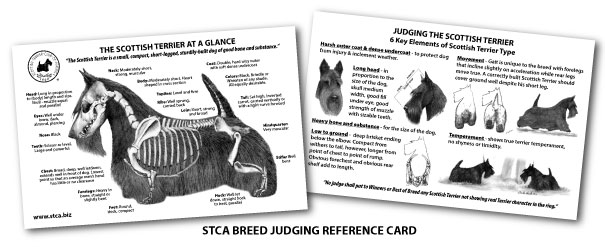AKC Breed Standard
The official Breed Standard for the Scottish Terrier was developed by the STCA in accordance with AKC guidelines.The current version was submitted to the AKC and approved on October 12, 1993.The most frequent use of the standard is by AKC judges when evaluating dogs in the conformation ring. The standard is also used by Scottie breeders to evaluate their own breeding program.
SCOTTISH TERRIER COAT COLORS
Scottish Terriers do come in a variety of coat colors. The approved AKC standard allows for most colors, except white. The purpose of this page is to provide several examples of the variation in coat color that are recognized within the standard.
Coat color is an area that comes down to strictly personal preference. Coat texture, length of coat, and the visual impact of different coat colors are factors that are beyond the scope of this explanation.

The Black Scottie — There may be an occasional hair strand that is not black. Single white hairs against an otherwise pure black coat is a clear indication that the dog is naturally black.

A very dark brindle (almost black) Scottie –Notice the brown on the side, forechest and beard as well as the silver around the neck.

The Brindle Scottie — Notice the clear indication of color variation. Color changes are noticeable on each hair strand, not just from one strand to another.

Another Brindle Scottie — Again notice the color variation across the entire coat. This Scottie has more red shades in the color variations.

And yet another Brindle Scottie — This Scottie has more silver showing in the coat color.

A Wheaten Scottie — The Wheaten Scottie is NOT a white Scottie, nor is it a Wheaten Terrier. The Wheaten coat is distinctively different from the Brindle in color, but it exhibits the same characteristic of color variation along each individual hair strand.

Importance of the Breed Standard
The Breed Standard is the yard stick that every dog show judge should use when evaluating your entry in the ring. The standard has been prepared and updated by the Scottish Terrier Club of America, because we are recognized by the AKC as the steward for this breed. The standard is a description of the “ideal” Scottish Terrier. Every AKC judge that has been approved to evaluate this breed is recommended to use this description to visualize their own version of this ideal Scottie. Then as they judge each entry in the ring, their objective is to compare that entry to their vision, picking the one that comes closest to the ideal.
Why is it so important?
The Scottish Terrier Breed Standard is so important because it helps guide and direct everyone associated with the breed. As discussed above, judges use it to visualize their ideal Scottie and then evaluate every show entry. But breeders are using the standard as well. Again, each breeder has their own visual interpretation of the standard.

